**Disclaimer** This is NOT a mushroom identification/field guide. I highly suggest that you take a mushroom course with an expert at a local college or join your local Mycological society and learn how to identify Morel mushrooms. This is how to find morels, not identify them. This simply an aid to those who have already learned how to properly and safely identify this mushroom. **
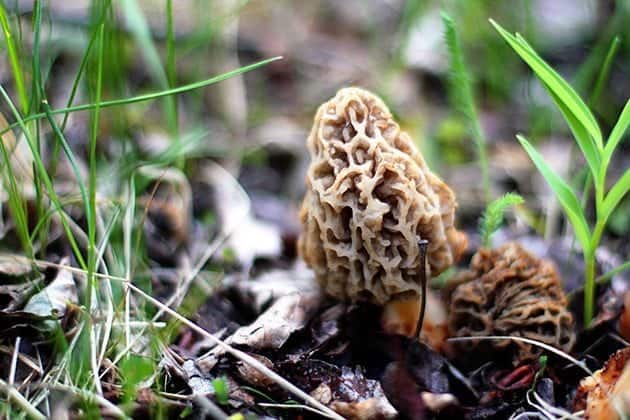
Part Two of How To Find Morels in Alberta came about because apparently I have far too much to write about when it comes to foraging morels. When I read through my post I thought “Holy Hannah, there is no way anyone is going to scroll that darn much to read one article.” and Part Two was born.
While Part One was all about learning when morels are is season in your specific area and listening to the signs that Nature is giving you, Part Two gets on to the nitty gritty of actually getting out in the field and hunting those beauties!
While I’m most certainly not an expert, my family has been foraging morels for years. I also happen to be armed with a camera and nothing pleases me more than to write up a real life foraging outing, picture by picture, story by story.
It’s not just a how-to, I had to get out there and find those little buggers. I can write about how to find morels until I am blue in the face but until I actually get out there and do it, there’s no proof I have any idea what I’m talking about.
Not that I have any idea of what I am talking about, of course.
On to Part Two!
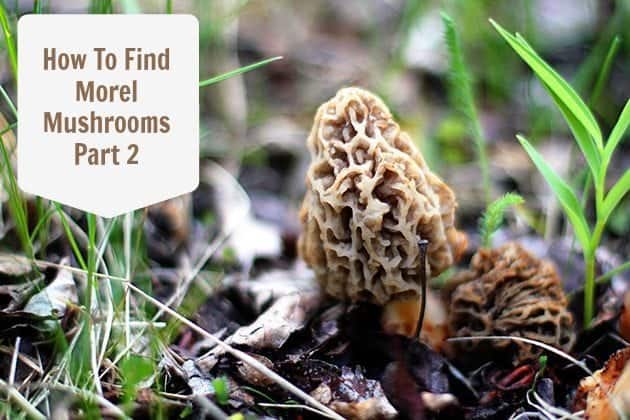
Where to look for morels in Alberta.
The million dollar question, folks, where to look for morel mushrooms. There’s a famous saying that “morels will grow anywhere but not everywhere” and that statement rings with the truth via the frustrated groans of mushroom hunters everywhere.
It might almost be easier to tell you where they usually don’t grow, but this past weekend taught me a few new things, mainly about golden morels which were the type we were foraging.
I found golden morels in:
Sandy soil – my Grandmother would have scoffed out loud at this and not believed it.
Tall grass- Say whaaat? This breaks all the morel rules you have ever been told.
Mixed in a swampy area with pine and tall willow-type trees with silver leaves and perfumed yellow flowers. I would have said silver willow but a botanist I am not. Take a look at the picture of my sister below and if anyone knows the type of tree, then that’s where we found morels galore in the long, swampy grass below them. There’s a first for everything!
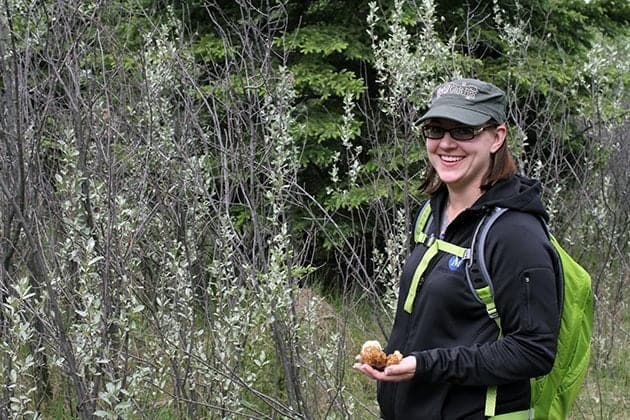
I have taken pictures of the very typical places you will find morels. The “X” below in the picture marks the spot where I found two gorgeous golden morels.
This is the most typical morel terrain that you will find, one that is mentioned in all books, articles and more. Here you find:
– The edge of the forest. Morels typically will grow in clearings or at the edge of large forested areas.
– Dead wood. I found them right at the base of a tree stump.
-Short grass. This is typically where you are told you will find morels and it’s almost always correct.
– A mixture of typical Alberta deciduous trees such as poplars and Saskatoons
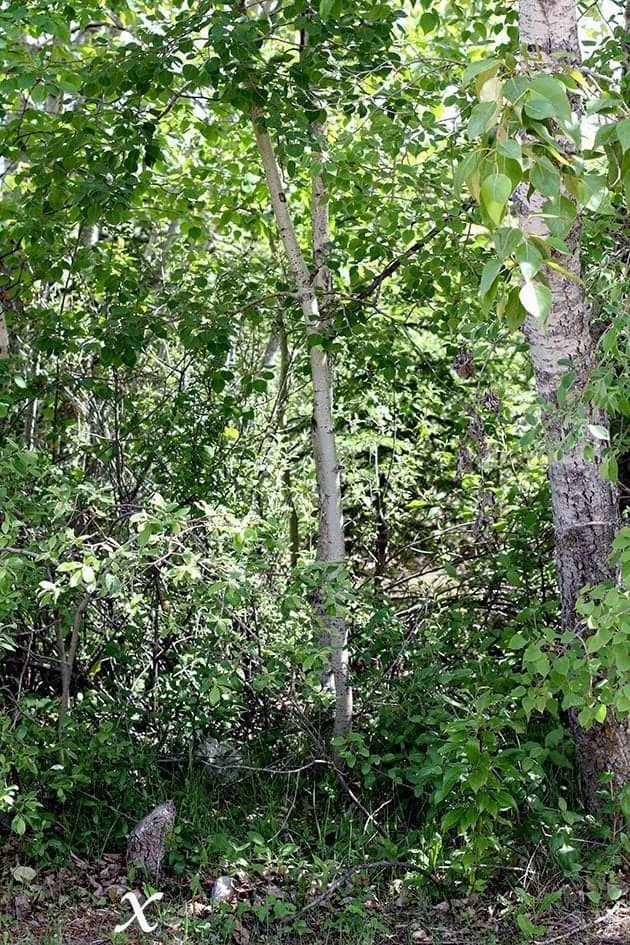
Be prepared to walk.
And walk and walk and walk.
That first morel is always the hardest to find. Indeed, all bragging rights aside, I found the first morels our first weekend out foraging and up until almost the very end of this past successful weekend my sister hadn’t found a single one. Once she did, there was no stopping her, but it seems that something almost has to “click” inside your head to pick them out of the landscape. Once you find the first one it’s almost as if your brain rewires and says “Aha! I see what shape and colour I need to be picking out of the landscape visually.”
Always stop at “typical” areas and give it a good visual once-over.
You may have trips with nothing – I have all the time- but the trick is perseverance.
Keep walking and keep looking. You will find them if you cover enough ground and space out your hunts with a couple of days between them to make sure you are catching the right growth time.
Be sure not to waste your time on areas that don’t fit the typical terrain even though there is always a possibility that morels are there. Those areas come later when you have that “Aha!” moment seared into your brain. That’s when I started finding them in the long grass, with three successful forays under my belt and many mushrooms into the game.
Now this area here is so perfect, so typical of morel terrain that I had to take a picture.
Well drained black earth near a drainage ditch, lots of dappled sun, mainly patches of earth, not grass, the grass that is there is barely taller than 3 inches, dead tree stumps, a poplar tree..
…and can you find the morel in the picture?
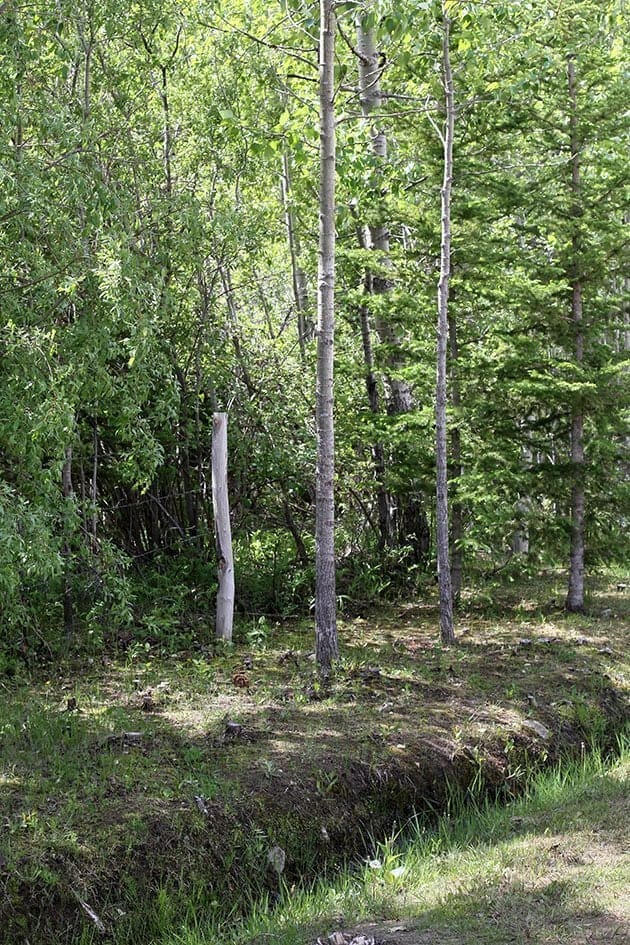
Did you spot it?
Once I found this one, I sank down to one knee, scanned the area and spotted three more to the left of this one, out of the picture. Where there is one there can be others. I won’t say usually because I am finding that with golden morels they seem to come in one or two’s but rarely as I found the ones matching the fellow below. Four within eyesight was a bonanza!
So when you do find one – and you will – before you pick it take a good long look at it from standing up. See what it looks like from that point of view and get used to the sight of it. Then get down and look around for others.
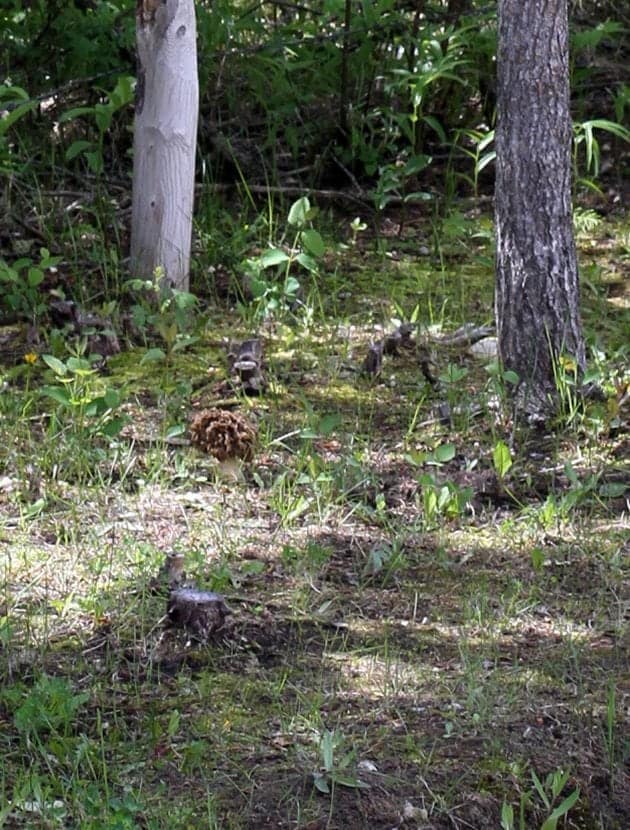
I can’t stress enough that before you eat any mushrooms that you take a course first. Take a walk with your local Mycological Society and start learning. Never try a new mushroom in large quantities- many people are simply allergic to them- and always err on the side of caution. I forage for mushrooms all year round, but you won’t see me eating them most times. We take out a book and find different mushrooms to try to identify them, learn about them and they don’t even hit my supper table in a meal.
Nothing I have told you in either part of this series is going to equip you for identification which is the most important part for safety. Learn, read and talk to the experts.
Remember the morel in the picture above?
We left it.
Sure, I could have checked it on all the points for safety, but it was too “brain” looking for our tastes, leaning towards a false morel more. Even though we found “real” morels in the same area, that one stayed where it was.
Unless I can 100% accurately identify a mushroom, it’s not coming close to my plate.
So happy and safe hunting everyone!
Thanks for stopping by and reading!
Love,
Karlynn
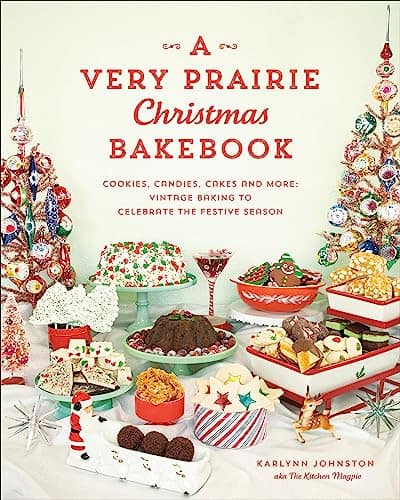
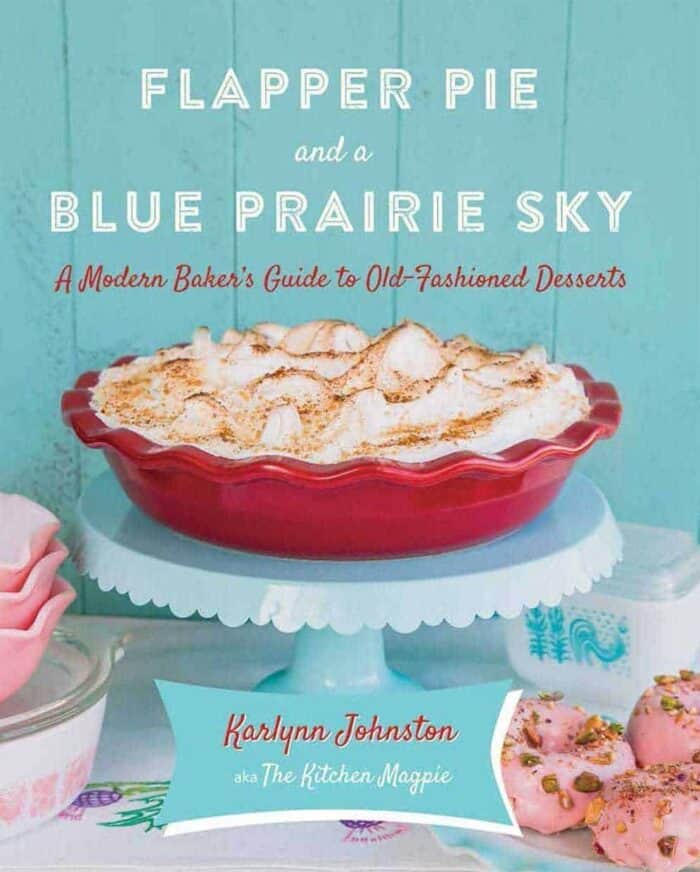
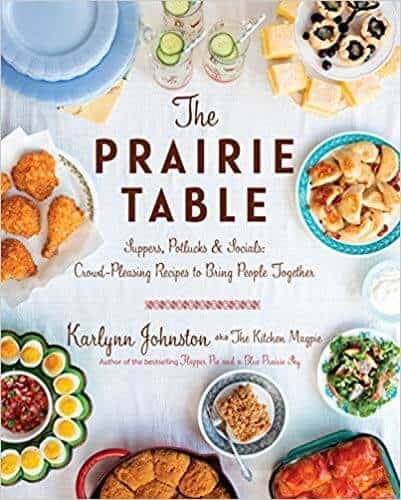



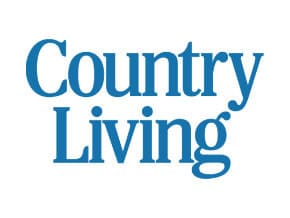




Margaret Holmes (Marg) says
I grew up in central Manitoba- and morels were found anywhere in the woods- I didn’t know it was only found in SPRING??? But Mom pan-fried them in butter? (I think…) on the stove and we ate them whenever they were available….
I do wonder if they are found in other provinces besides Manitoba??? In spring only? Which would be Feb through April or May???
robyn says
Hi Karlynn, the shrub you’re wondering about (silver with yellow flowers) is called silverberry (Eleagnus commutata) 🙂
David Enfield says
In the far north we have found hundreds of kg of morels…in areas that have been burnt out the previous year. The Peckerheads, blacks, grey, yellow and golds. Why is this?
The Kitchen Magpie says
I do not, we usually are out of Edmonton camping but I’ve heard they can be found in the River Valley!
Jaimee Morozoff says
Do you have any favourite places in the Edmonton area? 🙂
Crystal says
I am so excited for the season this year. I am from Illinois and our whole family would hunt then we would have a big family party. Usually over a 1000 morels would’ve cooked and eaten. I have been in Canada now for 14 years and have yet to find 1 so this is my year thanks for all your advice.
thekitchenmagpie says
@Crystal OH I would LOVE to be going on those big morel hunts you have in the States! I just salivate looking at all the pictures!! Good luck and happy hunting!
Simone says
Where exactly do you go mushroom picking, what location? I’ve been so many places and can’t find a good Forest. Are you around elk island park?
Genevieve Olivier says
Ahhh. Crappy. But totally understand.
The Kitchen Magpie says
I can’t come 🙁 weekends are completely booked up with being at the lake, all summer long! The event sounds so AWESOME with foraging and fishing, but right in the middle of the long weekend, which means my entire family will be at the lake…
Genevieve Olivier says
Are you coming to the SFE Foraging Event? We could use your expertise! 😀